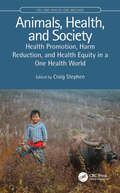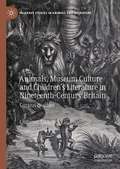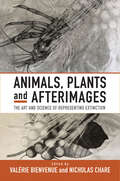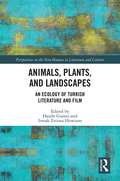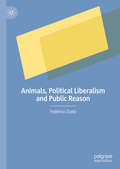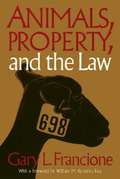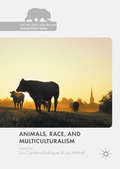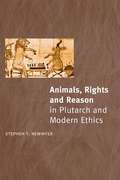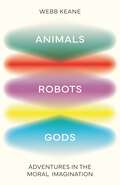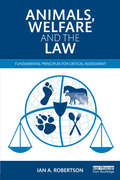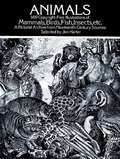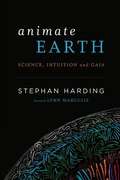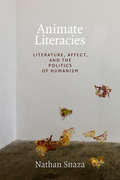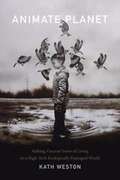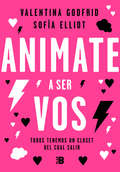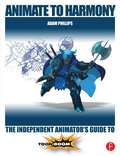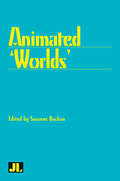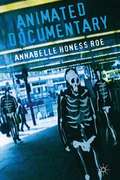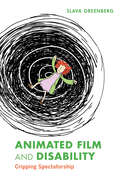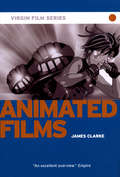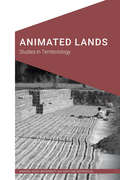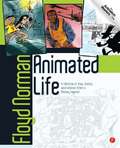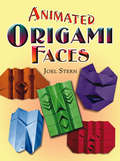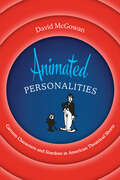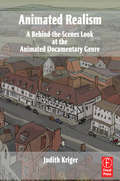- Table View
- List View
Animals, Health, and Society: Health Promotion, Harm Reduction, and Health Equity in a One Health World (CRC One Health One Welfare)
by Craig StephenThis timely book reframes the historic narrative of people, animals, and nature as risks to each other, to one where we think about health as a shared capacity. This new narrative promotes the positive contributions made to health across species and generations and addresses growing calls to shift from a reactive to proactive approach in One Health. Editor Craig Stephen takes the reader on a tour of the situations wherein we can all, regardless of our job description, work across species, sectors, and generations to motivate action. Perspectives and methods from a variety of fields and experts are shared and adapted to promote collaborative understanding of and action on determinants of health at the animal-society interface. Case studies demonstrate that the principles and practices presented are feasible, empowering people to make choices that concurrently benefit the health of animals, societies, and ecosystems. The first book to adapt and explain health promotion, harm reduction, and health equity issues in a One Health context, and in terms of animal health, this is necessary reading for students of and practitioners working in planetary health, conservation, ecohealth, public health, health promotion, veterinary medicine, and animal welfare.
Animals, Museum Culture and Children’s Literature in Nineteenth-Century Britain: Curious Beasties (Palgrave Studies in Animals and Literature)
by Laurence TalairachAnimals, Museum Culture and Children’s Literature in Nineteenth-Century Britain: Curious Beasties explores the relationship between the zoological and palaeontological specimens brought back from around the world in the long nineteenth century—be they alive, stuffed or fossilised—and the development of children’s literature at this time. Children’s literature emerged as dizzying numbers of new species flooded into Britain with scientific expeditions, from giraffes and hippopotami to kangaroos, wombats, platypuses or sloths. As the book argues, late Georgian, Victorian and Edwardian children’s writers took part in the urge for mass education and presented the world and its curious creatures to children, often borrowing from their museum culture and its objects to map out that world. This original exploration illuminates how children’s literature dealt with the new ordering of the world, offering a unique viewpoint on the construction of science in the long nineteenth century.
Animals, Plants and Afterimages: The Art and Science of Representing Extinction
by Nicholas Chare Valérie BienvenueThe sixth mass extinction or Anthropocene extinction is one of the most pervasive issues of our time. Animals, Plants and Afterimages brings together leading scholars in the humanities and life sciences to explore how extinct species are represented in art and visual culture, with a special emphasis on museums. Engaging with celebrated cases of vanished species such as the quagga and the thylacine as well as less well-known examples of animals and plants, these essays explore how representations of recent and ancient extinctions help advance scientific understanding and speak to contemporary ecological and environmental concerns.
Animals, Plants, and Landscapes: An Ecology of Turkish Literature and Film (Perspectives on the Non-Human in Literature and Culture)
by Hande Gurses Irmak Ertuna HowisonThe landscape of Turkey, with its trees and animals inspires narratives of survival, struggle and escape. Animals, Plants, and Landscapes: An Ecology of Turkish Literature and Film, will be the first major study to offer fresh theoretical insight into this landscape, by offering a collection of analyses of key texts of Turkish literature and cinema. Through discussion of both classical and contemporary works, this volume, paves the way for the formation of a ecocritical canon in Turkish literature and the rise of certain themes that are unique to Turkish experience. Snakes, fishermen and fish who catch men, porcupines contemplating on human agency, dogs exiled on an island and men who put dogs to fights, goat herders and windy steppes of Anatolia are all agents in a territory that constantly shifts. The essays included in this volume demonstrate the ways in which the crystallized relations between human and non-human form, break, and transform.
Animals, Political Liberalism and Public Reason
by Federico ZuoloThis book explores the problem of disagreement concerning the treatment of animals in a liberal society. Current laws include an unprecedented concern for animal welfare, yet disagreement remains pervasive. This issue has so far been neglected both in political philosophy and animal ethics. Although starting from disagreement has been the hallmark of many politically liberal theories, none have been devoted to the treatment of animals, and conversely, most theories in animal ethics do not take the disagreement on this issue seriously. Bridging this divide with a change of perspective, Zuolo argues that we should begin from the disagreement on the moral status of animals and the treatment we owe them. Reconstructing the epistemic nature of disagreement about animals, Zuolo proposes a novel form of public justification to find principles acceptable to all. By setting out a unified framework which honours the liberal principles of respect for diversity, a robust liberal political theory capable of dealing with diverse forms of disagreement, and even some forms of radical dissent, is achieved.
Animals, Property, and the Law
by Gary L. Francione"Pain is pain, irrespective of the race, sex, or species of the victim," states William Kunstler in his foreword. This moral concern for the suffering of animals and their legal status is the basis for Gary L. Francione's profound book, which asks, Why has the law failed to protect animals from exploitation? Francione argues that the current legal standard of animal welfare does not and cannot establish fights for animals. As long as they are viewed as property, animals will be subject to suffering for the social and economic benefit of human beings. Exploring every facet of this heated issue, Francione discusses the history of the treatment of animals, anti-cruelty statutes, vivisection, the Federal Animal Welfare Act, and specific cases such as the controversial injury of anaesthetized baboons at the University of Pennsylvania. He thoroughly documents the paradoxical gap between our professed concern with humane treatment of animals and the overriding practice of abuse permitted by U. S. law. Author note: Gary L. Francione is Professor of Law and Nicholas de B. Katzenbach Scholar of Law at Rutgers University Law School, Newark. He is also Co-director of the Rutgers Animal Rights Law Center.
Animals, Race, and Multiculturalism (The Palgrave Macmillan Animal Ethics Series)
by Luís Cordeiro-Rodrigues Les MitchellThis book focuses on multiculturalism, racism and the interests of nonhuman animals. Each are, in their own right, rapidly growing and controversial fields of enquiry, but how do multiculturalism and racism intersect with the debate concerning animals and their interests? This a deceptively simple question but on that is becoming ever more pressing as we examine our societal practices in a pluralistic world. Collating the work of a diverse group of academics from across the world, the book includes writing on a wide range of subjects and addressing contemporary issues in this critical arena. Subjects covered include multiculturalism, group rights and the limits of tolerance; ethnocentrism and animals; racism and discrimination and non-Western alternatives to animal rights and welfare. The book will be of interest to researchers, lecturers and advanced students as well as range of social justice organisations, government institutions, animal activist organisations and environmental groups.
Animals, Rights and Reason in Plutarch and Modern Ethics
by Stephen T. NewmyerThis groundbreaking volume explores Plutarch's unique survival in the argument that animals are rational and sentient, and that we, as humans, must take notice of their interests. Exploring Plutarch's three animal-related treatises, as well as passages from his ethical treatises, Stephen Newmyer examines arguments that, strikingly, foreshadow those found in the works of such prominent animal rights philosophers as Peter Singer and Tom Regan. Unique in viewing Plutarch’s opinions not only in the context of ancient philosophical and ethical through, but also in its place in the history of animal rights speculation, Animals Rights and Reasons points out how remarkably Plutarch differs from such anti-animal thinkers as the Stoics. Classicists, philosophers, animal-welfare students and interested readers will all find this book an invaluable and informative addition to their reading.
Animals, Robots, Gods: Adventures in the Moral Imagination
by Webb KeaneA mind-expanding exploration of the ethical bonds we share with the nonhumanMoral relationships saturate the living world, and the line between the human and nonhuman is blurrier than we might think. Animals, Robots, Gods provides a bold new vision of ethics defined less by the individual mind or society and more by our interactions with those around us, whether they are the pets we keep, the gods we believe in, or the machines we endow with life.Drawing on pioneering fieldwork around the globe by some of today&’s leading researchers, acclaimed anthropologist Webb Keane invites us to expand our moral imagination. We learn about the ethical dilemmas of South Asian animal rights activists, Balinese cockfighters, cowboys, and Japanese robot fanciers. We meet a hunter in the Yukon who explains to a bear why it must come out of hibernation and generously give itself up to him, a cancer sufferer in Thailand who sees his tumor as a reincarnated ox, and a computer that persuades users to confess their anxieties as if they were patients on a psychiatrist&’s couch. Through these and other stories, Keane challenges us to rethink our most basic ideas about who—and what—we deem worthy of moral consideration.Brimming with charm, wit, and insight, Animals, Robots, Gods reveals how centuries of conversations between us and nonhumans inform our conceptions of morality and will continue to guide us in the age of AI and beyond.
Animals, Welfare and the Law: Fundamental Principles for Critical Assessment
by Ian A. RobertsonIn this objective, practical and authoritative introductory text the author reveals how the fundamental principles of the human-animal relationship drive the development of animal law. The book explains the criteria by which the lawful use of animals is determined, and how these criteria impact evolving standards of animal protection and define the responsibilities of people in their interactions with animals. The author identifies 29 key principles which constitute the core knowledge necessary for people involved in debating, assessing, and guiding the evolution of society’s national and international rulebook of animal welfare law. The book also considers animal welfare and law in the context of a global market through discussion of common issues such as climate change, biosecurity, food safety and food supply. Based on successful law courses run by the author and his own expertise as an animal law lecturer, prosecutor and specialist legal adviser, the book combines insights from science, ethics and law to provide an essential understanding of what informs society and the law with regards to animals and their welfare.
Animals: 1,419 Copyright-Free Illustrations of Mammals, Birds, Fish, Insects, etc (Dover Pictorial Archive)
by Jim HarterSelected for its visual impact and ease of use, this outstanding collection of wood engravings presents over 1,000 species of animals in extremely lifelike poses. Includes many different versions of familiar mammals, birds, reptiles, amphibians, fish, insects, and other invertebrates such as spiders, crabs, squid, earthworms, and more. Captions provide modern common-name identifications.
Animate Earth
by Lynn Margulis Stephan HardingModern science and western culture both teach that the planet we inhabit is a dead and passive lump of matter, but as Stephan Harding points out, this wasn't always the prevailing sentiment and in Animate Earth he sets out to explain how these older notions of an animate earth can be explained in rational, scientific terms. In this astounding book Harding lays out the facts and theories behind one of the most controversial notions to come out of the hard sciences arguably since Sir Isaac Newton's Principia or the first major publications to come out of the Copenhagen School regarding quantum mechanics. The latter is an important parallel: Whereas quantum mechanics is a science of the problem--it gave rise to the atomic bomb among other things--Gaia Theory in this age of global warming and dangerous climate change is a science of the solution. Its utility: Healing a dying planet becomes an option in a culture otherwise poised to fall into total ecological collapse. Replacing the cold, objectifying language of science with a way of speaking of our planet as a sentient, living being, Harding presents the science of Gaia in everyday English. His scientific passion and rigor shine through his luminous prose as he calls us to experience Gaia as a living presence and bringing to mind such popular science authors as James Gleick. Animate Earth will inspire in readers a profound sense of the interconnectedness of life, and to discover what it means to live harmoniously as part of a sentient creature of planetary proportions. This new understanding may solve the most serious problems that face us as a species today.
Animate Literacies: Literature, Affect, and the Politics of Humanism (Thought in the Act)
by Nathan SnazaIn Animate Literacies Nathan Snaza proposes a new theory of literature and literacy in which he outlines how literacy is both constitutive of the social and used as a means to define the human. Weaving new materialism with feminist, queer, and decolonial thought, Snaza theorizes literacy as a contact zone in which humans, nonhuman animals, and nonvital objects such as chairs and paper all become active participants. In readings of classic literature by Kate Chopin, Frederick Douglass, James Joyce, Toni Morrison, Mary Shelley, and others, Snaza emphasizes the key roles that affect and sensory experiences play in literacy. Snaza upends common conceptions of literacy and its relation to print media, showing instead how such understandings reinforce dehumanizations linked to dominant imperialist, heterosexist, and capitalist definitions of the human. The path toward disrupting such exclusionary, humanist frameworks, Snaza contends, lies in formulating alternative practices of literacy and literary study that escape disciplined knowledge production.
Animate Planet: Making Visceral Sense of Living in a High-Tech Ecologically Damaged World
by Kath WestonIn Animate Planet Kath Weston shows how new intimacies between humans, animals, and their surroundings are emerging as people attempt to understand how the high-tech ecologically damaged world they have made is remaking them, one synthetic chemical, radioactive isotope, and megastorm at a time. Visceral sensations, she finds, are vital to this process, which yields a new animism in which humans and "the environment" become thoroughly entangled. In case studies on food, water, energy, and climate from the United States, India, and Japan, Weston approaches the new animism as both a symptom of our times and an analytic with the potential to open paths to new and forgotten ways of living.
Animate a ser vos: Todos tenemos un clóset del cual salir
by Valentina Godfrid y Sofía Elliot Sofía Elliot«Este libro nace del deseo de que nuestra historia pueda ayudar a cualquier persona que sienta que no puede vivir en libertad. Porque creemos que lo más importante de este camino es que sepas que tenés derecho a ser».Sofi y Valen Esta es una historia de amor y libertad, y además una historia de resiliencia. Esta es la historia de Sofía y Valentina, dos chicas que se conocieron, se enamoraron y se animaron a salir del clóset juntas, casi al mismo tiempo. Pero no solo tuvieron que hacerlo por su orientación sexual, sino también para liberarse de miedos, secretos, mandatos y tabúes, confiar en su deseo y su autonomía, luchar para convertirse en quienes verdaderamente son. A través de los desafíos que debieron enfrentar, nos invitan a pensar sobre el valor de las palabras, el respeto por el cuerpo y la importancia del amor y la libertad. «Este libro nace de la voluntad de que nuestra historia pueda ayudar a cualquier persona que sientaque no puede vivir en lib ertad. Porque creemos que lo más importante de este camino es que sepas que tenés derecho a ser. Esperamos que te acompañe como un amuleto, como una guía para animarte a emprender y materializar tus deseos. Esperamos que puedas sumar herramientas para entender el valor de honrar tu alma, tus sueños, tu cuerpo».SOFI y VALEN
Animate to Harmony: The Independent Animator's Guide to Toon Boom
by Adam PhillipsWant to create studio-quality work and get noticed? Just coming off Flash and looking for a Toon Boom intro? Are you a traditional pencil-and-paper animator? From scene setup to the final render, learn how to navigate the Toon Boom interface to create animation that can be published on a variety of platforms and formats. Animate to Harmony guides you through Toon Boom’s Animate, Animate Pro and Harmony programs, teaching you how to create high-quality 2D animation of all complexities. The main text focuses onfeatures that are common across all three programs while "Advanced Techniques" boxes throughout the book elaborate on Pro and Harmony features, appealing to all levels of experience with any of the three main Toon Boom products.
Animated 'Worlds'
by Suzanne BuchanWhat do we mean by the term "animation" when we are discussing film? Is it a technique? A style? A way of seeing or experiencing "a world" that has little relation to our own lived experience of "the world"? In Animated Worlds, contributors reveal the astonishing variety of "worlds" animation confronts us with. Essays range from close film analyses to phenomenological and cognitive approaches, spectatorship, performance, literary theory, and digital aesthetics. Authors include Vivian Sobchack, Richard Weihe, Thomas Lamarre, Paul Wells, and Karin Wehn.
Animated Documentary
by Annabelle Honess RoeAnimated Documentary, the first book to be published on this fascinating topic, considers how animation is used as a representational strategy in nonfiction film and television and explores the ways animation expands the range and depth of what documentary can show us about the world. On behalf of the Society for Animation Studies(SAS), the Chair of the Jury announced the book as the winner of the delayed 2015 SAS McLaren-Lambart Award with the following words: 'Animated Documentary is a vital addition to both animation scholarship and film studies scholarship more broadly, expertly achieving the tricky challenge of synthesising these two scholarly traditions to provide a compelling and brilliantly coherent account of the animated documentary form. At the heart of Roe's book is the conviction that animated documentary "has the capacity to represent temporally, geographically, and psychologically distal aspects of life beyond the reach of live action" (p. 22). As a representational strategy, Roe details how animated documentary can be seen to adopt techniques of "mimetic substitution, non-mimetic substitution and evocation" in response to the limitations of live action material (p. 26). Animated Documentary will without doubt become an essential resource for many years to come for anyone interested in the intersection of animation and documentary. '
Animated Film and Disability: Cripping Spectatorship
by Slava GreenbergWhile many live-action films portray disability as a spectacle, "crip animation" (a genre of animated films that celebrates disabled people's lived experiences) uses a variety of techniques like clay animation, puppets, pixilation, and computer-generated animation to represent the inner worlds of people with disabilities. Crip animation has the potential to challenge the ableist gaze and immerse viewers in an alternative bodily experience.In Animated Film and Disability, Slava Greenberg analyzes over 30 animated works about disabilities, including Rocks in My Pockets, An Eyeful of Sound, and A Shift in Perception. He considers the ableism of live-action cinematography, the involvement of filmmakers with disabilities in the production process, and the evocation of the spectators' senses of sight and hearing, consequently subverting traditional spectatorship and listenership hierarchies. In addition, Greenberg explores physical and sensory accessibility in theaters and suggests new ways to accommodate cinematic screenings.Offering an introduction to disability studies and crip theory for film, media, and animation scholars, Animated Film and Disability demonstrates that crip animation has the power to breach the spectator's comfort, evoking awareness of their own bodies and, in certain cases, their social privileges.
Animated Films - Virgin Film
by James ClarkeAnimation has never been so popular. The best animated films have combined the latest technology with creativity and a flair for storytelling and are adored by both children and adults. With films such as Monsters, Inc., Shrek and Toy Story capturing the imagination of moviegoers and critics, animated film is enjoying a resurgence unseen since its golden age in the 30s and 40s. From the earliest full-length feature animation, Disney's Snow White and the Seven Dwarfs, through stop-motion animation and Japanese anime to the advent of CGI, this book takes a critical look at animation through the ages and explores its infinite cinematic possibilities.
Animated Lands: Studies in Territoriology (Cultural Geographies + Rewriting the Earth)
by Andrea Mubi Brighenti Mattias KärrholmIn Animated Lands Andrea Mubi Brighenti and Mattias Kärrholm focus on territory as a living phenomenon—and territoriality as an active and constantly reshaping force. They explore the complexity of territorial production through a series of parallel investigations into fundamental territorial themes, such as rhythm, synchronization, melody, morphogenesis, and animism. The notion of territory is excavated through case studies including the analysis of urban playgrounds, homemaking, the transformations of urban walls, and the stabilization of peculiar building types such as the house-museum. These empirical examples span such cities as Ahmedabad, Amsterdam, London, and Rome. Animated Lands provides a broad introduction to what a theory of territories could be and how it could help to advance sociospatial studies.
Animated Life: A Lifetime of tips, tricks, techniques and stories from a Disney Legend
by Floyd NormanA well designed, well written animated film has warmth, humor and charm. Since Steamboat Mickey, animators have been creating characters and films that are charming, warm and humorous, allowing people to connect with the animated medium. Animaton fans love the characters for a lifetime. This is the legacy of the countless animators and artists who created the classic characters and fun stories and the legacy of Disney Legend, Floyd Norman. Written with wit and verve, Animated Life is a guided tour through an entire lifetime of techniques, practical hands-on advice and insight into an entire industry. A vital tutorial in animation's past, present and future for students who are now poised to be part of another new generation in the art form. Apply artistic magic to your own projects and garner valuable insight and inspiration from a True Disney legend. With valuable advice, critical comment, and inspiration for every student of the arts, Animated Life is a classic in the making with completely relevant techniques and tools for the contemporary animation or fine arts professional.
Animated Origami Faces
by Joel SternBlending the art of paperfolding with the magic of animation, this fun and fascinating book will help origami enthusiasts at every skill level create twelve delightful faces filled with movement and life. Using ordinary letter-size paper, anyone can make lively three-dimensional faces with blinking eyes, snapping jaws, and wiggling ears:* Talking Bird* Masked Super Hero* Blowfish* Elephant* Dog* Monkey ...and more!With this simple method of paperfolding, no tools or glues are required. Just follow the easy step-by-step diagrams, accompanied by tons of helpful tips on technique, and crystal clear illustrations. An inspiring way to create homemade masks, this unique guide also includes suggestions for creating your own movable models, letting crafters mix and match features to invent new and unusual origami species!
Animated Personalities: Cartoon Characters and Stardom in American Theatrical Shorts
by David McGowanThis pioneering book makes the case that iconic cartoon characters, such as Mickey Mouse, are legitimate cinematic stars, just as popular human actors are.Mickey Mouse, Betty Boop, Donald Duck, Bugs Bunny, Felix the Cat, and other beloved cartoon characters have entertained media audiences for almost a century, outliving the human stars who were once their contemporaries in studio-era Hollywood. In Animated Personalities, David McGowan asserts that iconic American theatrical short cartoon characters should be legitimately regarded as stars, equal to their live-action counterparts, not only because they have enjoyed long careers, but also because their star personas have been created and marketed in ways also used for cinematic celebrities.Drawing on detailed archival research, McGowan analyzes how Hollywood studios constructed and manipulated the star personas of the animated characters they owned. He shows how cartoon actors frequently kept pace with their human counterparts, granting &“interviews,&” allowing &“candid&” photographs, endorsing products, and generally behaving as actual actors did—for example, Donald Duck served his country during World War II, and Mickey Mouse was even embroiled in scandal. Challenging the notion that studios needed actors with physical bodies and real off-screen lives to create stars, McGowan demonstrates that media texts have successfully articulated an off-screen existence for animated characters. Following cartoon stars from silent movies to contemporary film and television, this groundbreaking book broadens the scope of star studies to include animation, concluding with provocative questions about the nature of stardom in an age of digitally enhanced filmmaking technologies.&“[Animated Personalities] is impressive for its lucid historical structure and exceptionally enjoyable content . . . McGowan breathes life into celluloid figures, giving readers a backstory for some of the most enduring iconic characters of screen history. This is a truly gratifying book.&” —Choice&“Combining historical, formal, and theoretical modes of analysis, Animated Personalities represents a vital contribution to both star studies and the study of animation in classical Hollywood and beyond. By embracing a key problematic of the study of stardom―the inability to take any element of its construction as authentic―McGowan does not undermine the validity of this approach so much as craft a more honest and complete understanding of it.&” —Synoptique
Animated Realism: A Behind The Scenes Look at the Animation Tools and Techniques of Award Winning Films
by Judith KrigerWith the development and accessibility of animation tools and techniques, filmmakers are blurring the boundaries between documentary filmmaking and animation. The intimacy, imperfection and charm of the animated form is providing live-action and animation directors with unique ways to tell stories, humanize events and convey information not easily adapted for live-action media. "Animated Realism" presents animation techniques as they apply to the documentary genre with an inspirational behind-the-scenes look at award-winning animated documentaries. Animators and documentary filmmakers alike will learn how to develop a visual style with animation, translate a graphic novel into a documentary and use 3D animation as a storytelling tool, all in the context of creating animated documentaries. With insight and inspiration, "Animated Realism" includes interviews from industry luminaries like John Canemaker, Oscar Winning Director of "The Moon and the Son", Yoni Goodman, Animation Director of Oscar Nominated Waltz with Bashir and Chris Landreth, Oscan Winning creator of Ryan. Packed with beautiful, instructive illustrations and previously unpublished material (including storyboards, photos and hand-drawn sketches) and interspersed with interviews - this is an exceptional source of inspiration and knowledge for animators, students and fans alike. With a companion website featuring animated shorts from leading animated documentaries, animators, students and documentary filmmakers will be able to analyze and apply Oscar-winning animation techniques to their own films. Learn from the best...Judith Kriger interviews some of the most innovative and inspirational animators, including John Canemaker, Oscar Winning Director of "The Moon and the Son", Yoni Goodman, Animation Director of Oscar Nominated Waltz with Bashir and Chris Landreth, Oscan Winning Director of Ryan.
